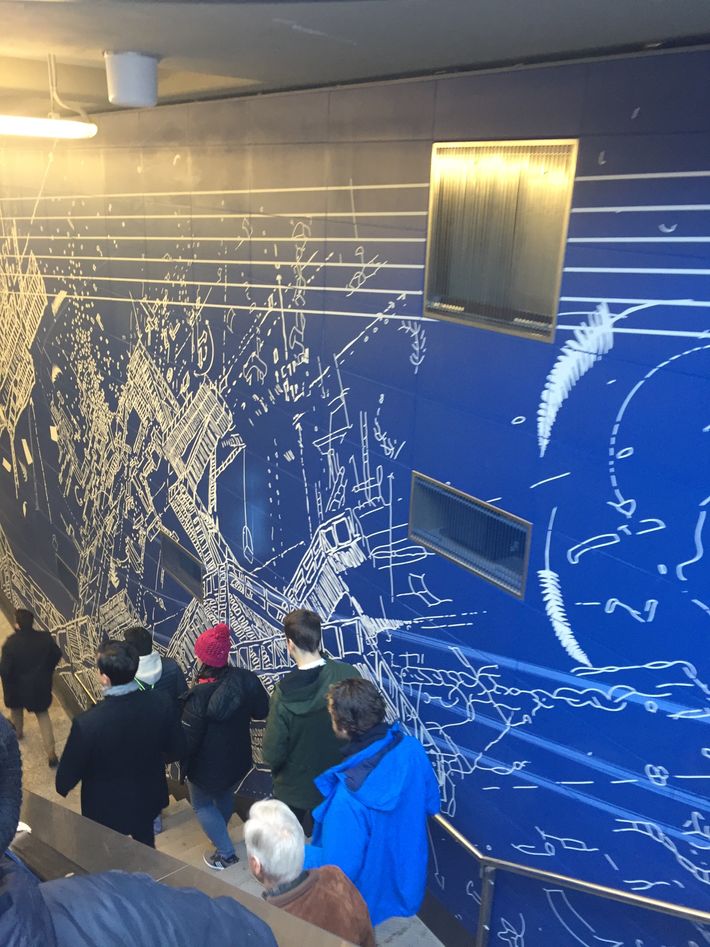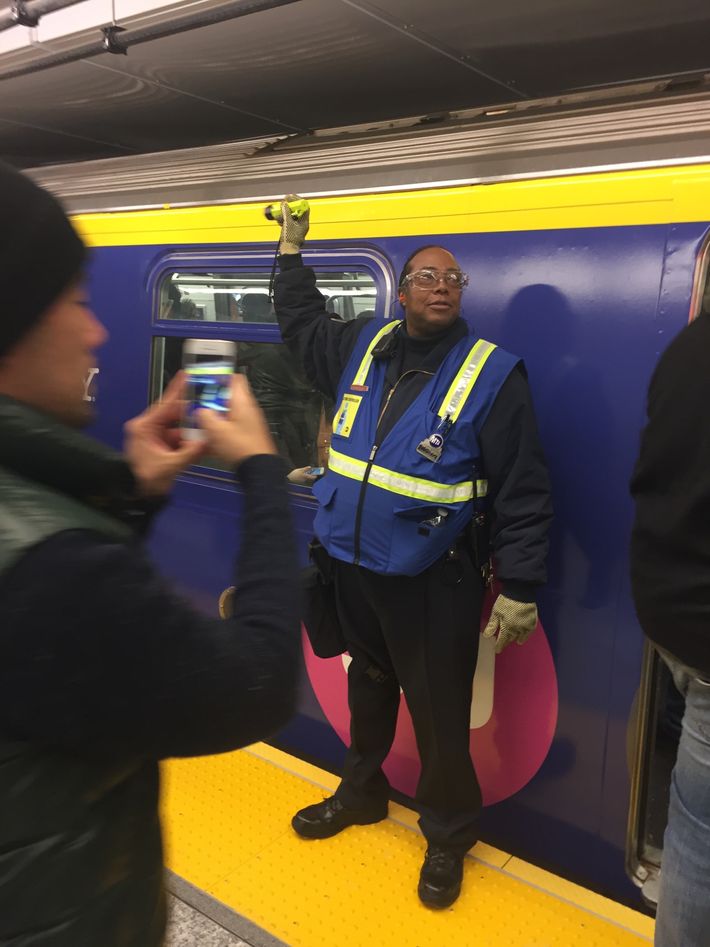
Danny Wrynn stands on the outskirts of the crowd smashed together at the still-blocked-off entrance to the gleaming 96th Street Station on Second Avenue. Wrynn, an MTA employee, wears a blue hat with the agency’s logo for his visit to the brand-new stop. “It’s never as nice as day one,” he says. He would know — and not just because he works the G train. He went to the Hudson Yards debut, and though it’s been awhile, he saw the opening of the Jamaica Center and the F train station at 21st Street–Queensbridge in Long Island City in the late 1980s. “I’m a train buff,” he adds.
He’s not the only subway enthusiast among those lined up at the entrance to the 96th Street Subway entrance, waiting for the station to officially — and finally — open at 11:45 a.m., ahead of the first departure of the re-branded Q at noon. Most are bundled in puffy coats, and there are plenty of kids wriggling at their parents’ feet. There’s some festive gear: a pair of hard hats; a few Q-train-themed ones; and a guy in 2017 glasses paying tribute to the New Year and the brand-new subway that’s arrived with it.
Others, like Brad Balfour, an Upper East Sider who lives around the corner from the 96th Street entrance, the line’s opening is more a consolation than a celebration. “It was torture from the minute it started,” he says. The Second Avenue line may be notorious not just for its expense, but also for its delays — it’s an infrastructure project dreamed up nearly a century ago — and those who stayed in the neighborhood have dealt with almost a decade of construction — a chorus of digging and drilling and the occasional unsettling blast.
“I’m glad it’s here now that it’s done,” Balfour says, “but it was a boondoggle.”
In keeping with that tradition, the clock ticks a few minutes past 11:45 a.m. before Governor Andrew Cuomo arrives, joining MTA chair Tom Prendergast at the 96th Street station’s entrance. Cuomo, who presided over the line’s swank inaugural ride and party the night before, welcomes the crowd, though his greeting doesn’t reach the back. “Shut up and open the subway,” a man yells. “Let’s go,” screams a woman.
And then the crowd jams forward: The Second Avenue subway is open. Smartphones and small digital cameras float above heads like satellites as people cross the threshold of the station, recording their descent down the escalators to the station below.

A Metrocard swipe is the price of admission into the station, which at 96th Street is outfitted with a mural, “Blueprint for a Landscape” by Sarah Sze. Everyone goes down another flight from the mezzanine to the tracks. The trains wait. Their silver sides are plastered with the new Second Avenue logo; the insides are uncharacteristically clean and plastered with pro–Second Avenue PSAs. The first train fills up on Track 2, rush-hour-delay packed. The doors close and it takes off, cameras following its path out of the station. An MTA station agent applauds, and other bystanders join in. One woman cries out: “Finally.”
Another MTA platform agent, standing in front of the yet-to-be-opened train still in the station, assures the people left behind. “You’ll be the first,” he says, “on Track 1.”

The doors open and people board the Q, grabbing seats or spots near the windows. “Stand clear of the closing doors, please,” says the PA. The doors ding shut. Straphangers erupt in cheers and applause as the train lurches forward, headed south.
“It’s wonderful, like being a kid in a candy store,” says Rebecca Cruz, an Upper East Sider who nabbed a seat. “Everyone is talking to each other.”
Beajea Payne, who lives in East Harlem, brought her three kids for the ride. Her 7-year-old son, Jamari, is autistic and a train fanatic. “We’ve been anticipating this for a long time,” she says. Her son wears a red hat and grips the subway pole while cradling an A train figurine. “I love the Q,” Jamari adds, with wonder, as the train departs.

After 86th Street, the Second Avenue subway becomes, well, the subway. “We are delayed because of train traffic ahead,” crackles the PA. People laugh — of course, they’re halted in a train tunnel already. But the novelty of being the first to be delayed on the Second Avenue line wears off fast. “Why won’t they tell us what’s going on?” someone asks aloud. A couple looks askance at a boy who is watching a video, no headphones, the sound on too high. A man in a blue jacket leans his forehead against the subway pole, closes his eyes.

As the train crawls to the next station, Sylvia Rivera, who lives in East Harlem, says she had to ride the train because she and her husband had been waiting decades for the line. Her husband, however, had missed it. “He passed away. He never got see it.” The ride was beautiful, she insists, before getting off at the next stop.
Bernice Canadate, a 54-year-old Upper West Side resident, grabs a seat when the train empties out. “I wanted to see if it was worth the wait.” It was, for the most part, except for the delays. “It was a longer ride than I expected,” she says. “I guess they’re testing us.”

By 57th and 7th Avenue, whatever spell that had made New Yorkers turn into tourists for a brief afternoon breaks. The train clears out. A woman opens a book and pages through it. A pile of crumbs has appeared near the car doors. A man with a rolling suitcase wedged between his legs says he is actually trying to get somewhere.
But back up at the new stations on Second Avenue, crowds are still pouring in. They didn’t get on the first train, maybe, but being there on opening day is good enough. Everyone needed a Second Avenue subway selfie — in front of Lou Reed, one of Chuck Close’s “Subway Portraits” at 86th Street, or the new subway maps, or even the waiting trains. At 96th Street, Steve Bloom, a native New Yorker who lives in Bensonhurst, snaps a few photos. He had traveled the entire Q line, from Coney Island, to get here. He says he didn’t doubt that the Second Avenue subway would open. “I just didn’t think it would be in my lifetime.”





























